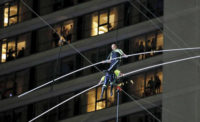Learning about “heat death of the universe” from a college physics professor is one reason Charlie Copeland has been at work for the past half-century as an energy conservation-minded mechanical engineer.
“At age 20 or so, I thought, ‘Whoa, so that’s the end of the universe?’” recalls the president and CEO of New York City-based engineering consultant Goldman Copeland Associates PC in sharing his thoughts on learning about the 19th-century theory by William Thomson, the First Baron Kelvin, of absolute-zero fame. It hypothesizes that when energy equalizes everywhere, stars will die and almost all matter will decay.
Continually thinking about the biggest picture, Copeland embarked on a career in which he tackles issues of renewable energy, sustainability and conservation, with solutions that aim to be the least complex and easiest on the client’s wallet. From designing one of New York City’s first solar water heaters for a project that launched the federal Public Utility Regulatory Policies Act (PURPA) to leading development of a 2018 geothermal prescreening tool for all 850,000 city lots, Copeland’s contributions have earned him ENR New York’s 2019 Legacy Award.
The engineer grew up in the College Point section of Queens and elsewhere in the city. Money was tight, with his mother eventually moving the family to a grandmother’s house in Westchester County, where Copeland attended school in the highly rated Ardsley district. Teachers and classmates encouraged him to take advanced academic courses, and a friend convinced him to attend an inexpensive Missouri college. Eventually, Copeland made his way back to the city and earned a master’s degree in mechanical engineering at City College of New York.
“My success is his success, and I never felt any different.”
– Eric Mitchell, Principal and Director of Mechanical Engineering, Goldman Copeland
The fledgling engineer supported himself by working nights and summers. Copeland got ground level views of construction by sling-blading rights-of-way for a natural gas pipeline in Arkansas and pulling concrete form pins for Interstate 80 in Iowa, among other jobs. These gigs and one small loan funded his education.
“Not possible with what universities charge now,” Copeland says, sympathizing with young people’s concerns about college tuition costs. The CEO’s empathy for others is apparent when talking with some of his employees who have thrived at Goldman Copeland.
“My success is his success, and I never felt any different,” says Eric Mitchell, principal and director of mechanical engineering, who nominated Copeland for the Legacy Award.
“He loves teaching people, he loves helping people advance their careers and continue their education,” adds principal Dan Colombini. “You can tell one of the things he takes pride in is seeing engineers grow. We all owe him the world.”
Tristan Schwartzman, Goldman Copeland's director of energy services, started at the firm in 2012 after teaching math in high school. With his degree in English literature, he and Copeland “talked about [novelist] Philip Roth books for about 20 minutes, then he offered me the job.” As he rose in the firm, Schwartzman says Copeland “would give me room to push the department into whatever direction I wanted to go. He gave me the chance to develop myself.”
The Legacy Award winner’s first job, meanwhile, was at Jaros Baum & Bolles. In 1970, he joined the start-up that became Goldman Copeland. The second line on his CV jumps out: “Designed one of New York City’s earliest multifamily residential solar collector domestic hot water systems at 519 East 11th St. The property subsequently installed a windmill to generate electricity, which became the standard for generation grid regulations.” The situation was actually much more colorful.
“Eleventh Street had completely abandoned cars lying on the sidewalk, with people taking parts out and selling them,” he remembers. “A lot of New York was in really bad shape … it had a ‘sweat equity program’ where you could literally get an apartment in an abandoned building like 519 East 11th if you were willing to put the work in to fix it up.”
The “semi-hippies” he says took over the building asked him in 1975 to design a system to heat water using solar energy collectors. At the time, the rules of how many solar collectors were needed per gallon of water “were completely in the favor of the solar collector makers,” but Copeland figured out a way to use fewer such devices.
With the use of solar power and a windmill that the building’s homesteaders put up, there was enough energy to plug electricity back into Con Edison’s grid —and the utility sued. Former U.S. Attorney General Ramsey Clark represented the residents, and the case led to the 1978 PURPA law that allows non-utility generators to produce power for use by customers attached to a utility’s grid, encouraging development of alternative energy.
Copeland’s conservation-minded engineering continued apace. Later in the 1970s, he traveled the country inspecting Veteran’s Administration hospitals to help them reduce energy consumption. In 1988, he managed engineering for the New York City Energy Conservation Capital program, the largest municipal energy conservation of its kind in the U.S., in which he studied some 500 buildings owned by the city and trained 20 consultants on how to perform energy audits.
That same year, Copeland began the 15-year program to upgrade the mechanical and electrical systems in Grand Central Terminal, which included disconnecting the steam service between the terminal and nearby buildings that were heated this way, installing sprinkler and smoke exhaust systems and bringing air conditioning to areas such as the main concourse that did not have it.
“We had a rule that one person was not allowed to walk through tunnels by themselves,” he says. “There were a lot of drugs, a lot of strange people”—including someone who had a mattress, wood planks and clothes in one of the empty vertical columns that Copeland and his team eventually used for the new lower level kitchen exhaust system.
“What’s most important to me now is what the future of civilization is.”
– Charlie Copeland, President and CEO, Goldman Copeland Associates
Entering the new millennium, Copeland upped his game. In 2004, he designed the first NYC office building built with a complete underfloor air system, for the Scholastic Books headquarters at 557 Broadway. The next year he created a similar system, using pew footrests at the Fifth Avenue Presbyterian Church, preserving the historic interior architecture. Other architecture-preserving projects have been the Alexander Hamilton Customs House, the Eldridge Street Synagogue and the Morgan Library.
The firm has also upgraded systems at various Broadway theaters, including the Schubert, Hudson, Roundabout, Dance Theater of Harlem and Playwrights Horizon. “I used to go to a lot of theater … it’s a little harder for me to stay out that late now and go to work in the morning,” he says.
In 2015, Copeland received a patent for a steam demand automatic control design that he did for Con Ed that helps high-rise office buildings reduce their peak winter demands. Three years later, he was principal in charge of developing the geothermal prescreening tool, at the request of the NYC Dept. of Design and Construction.
Copeland and his firm worked with a structural geological engineer and others to place data into the tool, look at ground surfaces to see what could prevent a construction team from going underground and develop engineering specific to the size of a plot and what kind of structure could be built on it. The tool looks at 25 types of buildings to determine the amount of energy required.
“Given lot sizes in New York, there are limited candidates to do geothermal. Some could do part-geothermal,” the engineer explains. “A lot of sites are good for a hybrid system, but that typically wouldn’t be any high-rise buildings. One- or two-family homes in Queens are a good application, or small apartment complexes.”
The tool has sparked interest outside New York City, and the firm has a contract to create something similar for Westchester County. Copeland says college campuses and farms would be good applications.
In 2019, Copeland returned to his electricity-generating roots. He oversaw the chiller plant and cooling tower infrastructure upgrade at the Penn South affordable housing complex, which produces its own electricity and is off the grid.
Copeland has been instrumental in promoting sustainability, but his approach has been tempered by practicality rather than a need to create high end, complex solutions. And clients appreciate it.
“What’s different about Charlie is that he encourages his clients to think more creatively about solutions. It’s not always the obvious solution that’s the right one,” says Dan Egan, co-president of the New York Energy Consumers Council and senior vice president of sustainability and utilities at Vornado Realty Trust, which is a longtime client of Goldman Copeland.
“He very much values existing infrastructure that’s unique to New York City, like district steam and figures out how to modernize it to meet today’s expectations,” Egan says. “He cared about sustainability long before sustainability was a buzzword. He cares about things working well, working efficiently and saving money for his clients— this comes from carbon savings, which also has environmental benefit.”
According to Vornado’s ESG Report, the company has spent more than $12 million on energy efficiency capital projects and earned a 27% rate of return.
“We’re pushing the envelope to be efficient. We’re not pushing the envelope to add fancy gadget ideas that are going to be more trouble than they’re worth or going to disappear in five years,” Schwartzman explains of his boss’ approach.
Looking forward, Copeland is eager to help clients comply with city statutes on clean energy and buildings, such as the New Green Deal or Local Law 97, which mandates large commercial buildings to meet carbon emissions limits by 2024.
“A lot of buildings we’ve looked at can get by now until 2024. But after that, many are going to be in trouble,” Copeland says. The firm has “been getting a lot of calls” from building owners worried about the law as well as about tenants’ concerns. It makes a big difference if it’s a new tenant such as a multinational bank “who doesn’t want to be seen as wasting energy,” the engineers says. “Some tenants won’t move into buildings that aren’t reasonably efficient.”
To Copeland, a grandfather of eight, it’s not just a money or legal issue. It’s about the industry helping to reduce global warming, whether by converting old mechanical systems or producing electricity more efficiently. “Eventually, if we can produce all electricity with solar and wind, that’s great, but that’s 20-30 years off. We need an intermediate technology,” he says. “What’s most important to me now is what the future of civilization is.”










Post a comment to this article
Report Abusive Comment